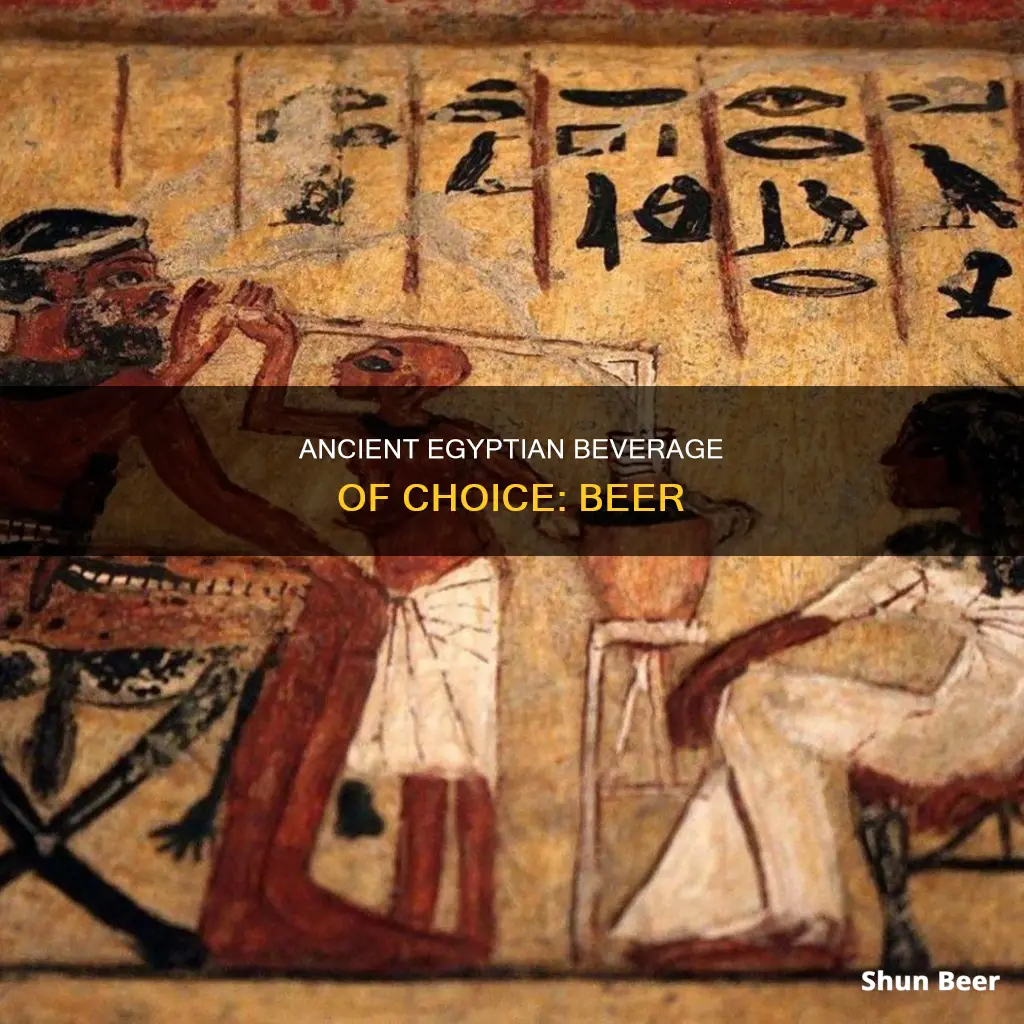
Beer was a staple of the ancient Egyptian diet and was enjoyed by both adults and children. It was considered a source of nutrition and was also used for ritual purposes. The ancient Egyptians were so well-known for brewing that their fame eclipsed the Sumerians, who invented the process. The drink was so important to ancient Egyptian society that it was offered to the gods and used as a form of payment for workers.
| Characteristics | Values |
|---|---|
| Name | "Hqt" ("heqet" or "heket"), "tnmw" ("tenemu"), "haAmt" ("kha-ahmet") |
| Importance | Central to ancient Egyptian society |
| Consumption | Enjoyed by adults and children of all social classes |
| Nutrition | Nutritious, thick, and sweet |
| Intoxication | Could be intoxicating, but not always |
| Religious significance | Offered to the gods, used for rituals and religious festivals |
| Wages | Used as payment for work |
| Brewing | Traditionally a female activity, though later became a state-funded industry presided over by men |
| Ingredients | Bread, rich yeasty dough, malt, barley, emmer, water, yeast, uncooked malt, dates, hops, honey |
| Alcohol content | 3-10% |
| Drinking method | Drunk from ceramic cups through tubes or straws |
What You'll Learn

Beer was drunk by all ages and classes
Beer was drunk by all ages and social classes in ancient Egypt. It was a staple food for both poor and wealthy Egyptians, and was consumed by adults and children alike.
In fact, beer was a common form of compensation for work. Workers at the Giza plateau, for example, received beer rations three times a day as payment. Beer was also used as payment for women who brewed it, allowing them to earn some extra money for themselves and their families.
Beer was also considered to have medicinal properties. It was frequently prescribed in medical texts, with over a hundred recipes for medicines including beer. Even when a prescription did not include beer, it was often suggested that the patient take the medicine with a cup of beer, which was thought to "gladden the heart". Beer was also believed to confuse the evil spirits that were considered the cause of many diseases.
Beer was further associated with nutrition and was often supplied by the state. It was mentioned as part of almost every major festival in ancient Egypt, and was also central to religious rituals. It was commonly supplied by the state for festivals such as the Opet Festival and the Beautiful Feast of the Wadi. The Tekh Festival, also known as the Festival of Drunkenness, was dedicated to the goddess Hathor and involved participants drinking to excess.
The ancient Egyptian brewing process was quite simple. It involved placing grain in cold water, heating grain in hot water, mixing the two together, and then rinsing the mixture into a vessel to ferment. The beer was then drunk as soon as it was fermented, often through straws to filter out the solid bits.
Beer and Guns: Can You Drink and Carry?
You may want to see also

It was used for ritual purposes
Beer was used for ritual purposes in ancient Egypt. It was considered the drink of the gods and was offered to them as a gift. Beer was also central to the story of Sekhmet's rampage and transformation into the kind and gentle goddess Hathor. In this story, the goddess is tricked into drinking beer dyed red, which she mistakes for blood, and becomes drunk and falls asleep. This event was commemorated during the Tekh Festival, also known as 'The Festival of Drunkenness', where participants would drink to excess and fall asleep, only to be awakened suddenly by the beating of drums.
Beer was also used in rituals at a nearby elite cemetery in Hierakonpolis, suggesting that it was symbolic of status and authority. The ancient beer was likely thick and cloudy, with a porridge-like consistency, and lower in alcohol content than modern beer.
Brewing and consuming beer was a highly organised and specialised industry in ancient Egypt, with evidence of more than a dozen breweries discovered through excavations. Beer was considered a staple food and was consumed by everyone, regardless of age or class. It was also used as a form of payment for labour and was frequently prescribed for health reasons.
Dancing and Drinking Beer: A Perfect Pair?
You may want to see also

Beer was a form of currency
The word for "payment for employment" in ancient Egyptian was "hemu", and the glyph for a beer jug was used in the hieroglyphic determinative. Beer was also central to the diet of the workers, who consumed it in large quantities. It was considered nutritious, thick, and sweet, and was often consumed through clay or reed straws.
The importance of beer in ancient Egypt extended beyond its use as a staple food and currency. Beer was also considered a gift from the gods and was frequently offered to them. According to Egyptian mythology, Osiris taught humanity the art of brewing beer, and the goddess Tjenenet presided over the craft. Beer was also mentioned in Egyptian literature and sayings, reflecting its cultural significance.
The process of brewing beer in ancient Egypt was primarily a female activity, allowing women to earn money or barter goods for themselves and their families. The main ingredient was bread made from a rich yeasty dough, which was lightly baked, crumbled, and strained through a sieve with water. Flavours such as dates were added, and the mixture was then fermented in a large vat and stored in large jars.
Mixed Drinks vs Beer: Which is the Superior Beverage?
You may want to see also

It was considered nutritious
Beer was a staple of the Egyptian diet, and it was considered a source of nutrition for all, regardless of age or class. It was enjoyed by both adults and children and was the staple drink of poor Egyptians, but it was also central to the diet of wealthy Egyptians.
The ancient Egyptian beer was nutritious, thick, and sweet. It was made from bread made from a rich yeasty dough, which was lightly baked, crumbled into small pieces, and strained through a sieve with water. Flavour was added in the form of dates, and the mixture was fermented in a large vat and then stored in large jars. It was also brewed from barley and emmer, which were heated and mixed with yeast and uncooked malt before being fermented to produce beer.
The ancient Egyptian brewers were mostly women, and the beer was often consumed fresh from the terracotta vat using a straw. It was also served to guests from pitchers and poured into ceramic cups. The beer was considered nutritious, with added sugars to increase the alcohol content. The more sugar that was added to the fermentation, the stronger the beer.
Beer was also frequently prescribed in medical texts. Over a hundred recipes for medicines included beer, and even when beer was not listed as an ingredient, patients were advised to take the medicine with a cup of beer, which was thought to "gladden the heart". Beer was also thought to confuse the evil spirits, which were considered the cause of many diseases. Precise recipes for these brews were never written down, but the general method used is clear from texts and small models of brewers found in tombs.
Beer Buddy: How It Works and Why It's Awesome
You may want to see also

Brewing was a female activity
> both brewing and baking were activities undertaken by women and numerous statuettes found in tombs show women grinding grain in mills or sifting the resulting flour.
Beer was initially brewed in homes by women and later became a state-funded industry run by men.
The early feminine influence on brewing is perhaps indicated by the deity who presided over the craft: Tenenet (also Tenenit, Tjenenet) the goddess of beer. Like the goddess Ninkasi of the Sumerians, Tenenet watched over brewers and ensured that the recipe was observed for the best quality beer.
The Sumerians had the Hymn to Ninkasi, which was basically the recipe for beer sung by brewers so they would memorise it, but no evidence of a similar song has been found in Egypt. However, hieroglyphics on tombs depict images of women both brewing and drinking the beverage.
The goddess Hathor was also considered to have invented brewing, and her temple at Dendera was known as "the place of drunkenness".
Mixed Drinks vs Beer: Which Packs a Harder Punch?
You may want to see also
Frequently asked questions
Yes, ancient Egyptians drank beer. It was enjoyed by both adults and children and was a staple drink for poor Egyptians, as well as being central to the diet of wealthy Egyptians.
Ancient Egyptian beer was thick, dark red, and sweet. It was made from cooked loaves of bread mixed with water and placed in heated jars to ferment. It also included ingredients such as dates, honey, and yeast. It is believed to have had an alcohol content of around 10%.
Beer was of central importance to ancient Egyptian society and culture. It was considered a source of nutrition and was used for ritual purposes. Beer was also used as a form of payment, with workers at the Giza plateau receiving beer rations three times a day as wages. It was also frequently mentioned in literature and sayings and was offered to the gods.







